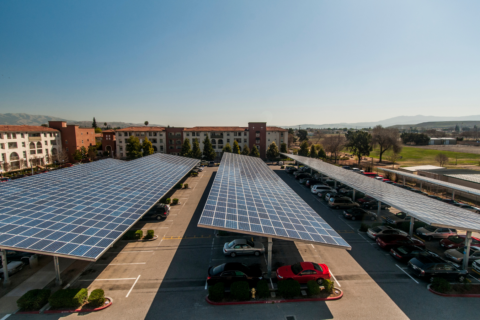Local government has a critical role to play in building and strengthening communities where all children can grow and live healthy lives. For quite some time, too many young children and families have had to live with and endure the consequences of adverse environmental conditions that impact their health and development. The effects of the physical environment on children’s well-being are profound and can influence every aspect of children’s development including their health and nutrition, their cognitive, social and emotional development, and their ability to take advantage of learning opportunities.
Environmental challenges (natural and built) such as pollutants, toxic exposure, overcrowding, housing, and neighborhood quality all influence early childhood outcomes. Climate change is exacerbating the impacts of these challenges on child development and the quality of life for families. Climate-related challenges such as rising temperatures, flooding, and extreme weather events threaten healthy pregnancy outcomes, create greater risk for developmental delays, increase the likelihood for asthma and allergies, and food insecurity while also increasing stress and affecting the parent’s ability to be responsive to their children, particularly in times of emergencies. Environmental challenges add to the cumulative stressors already faced by vulnerable populations such as people of color, pregnant women, young children (prenatal to three), and communities with high numbers of low-income families.
Municipal leaders across the country are well positioned to act and align the early childhood, climate, and environmental policy agendas to limit the impact these challenges will have on children, families, and their communities. Fortunately, the federal government is a strong partner and is providing resources that can help local leaders execute and implement strong local plans. The Inflation Reduction Act (IRA) provides an opportunity to aid local leaders in creating more resilient communities. This legislation includes a number of climate provisions that can impact young children, their families, and those that care for them. While both the climate and early childhood agendas are equally important, together they can strengthen communities and improve outcomes for some of its most vulnerable populations as well as future generations to come.
Cities in Action Connecting the Dots…
It is important to acknowledge that early childhood development happens well beyond the realms of childcare and formal educational settings. Children are born learning and brain development is most rapid in the first 1,000 days of life. Due to their size, physiology, and behavior, children are more vulnerable than adults to environmental hazards. In efforts to meet the needs of all residents, municipal leaders are prioritizing investments in infrastructure and services to address climate and environmental injustices. A few city examples to promote resiliency and innovation are referenced below.
- Rising temperatures and exposure to extreme heat can affect pregnancy outcomes. Exposure in this environment can reduce rates of conception and increase a pregnant woman’s risk of early labor and having a low-birth-weight baby. In 2021, the City of Phoenix, AZ City Council approved the establishment of a new office to coordinate efforts city-wide to address heat response, heat mitigation and oversee the implementation of the Tree and Shade Masterplan. The Office of Heat Response and Mitigation coordinates programs and policies to help lower urban temperatures and protect public health. It also tracks trends, collects data, and collaborates with other governments and organizations to share ideas and solutions when it comes to dealing with heat.
- Natural disasters such as hurricanes and flooding also affect maternal and child health. Maternal exposure to flood during pregnancy has been shown to increase the risk of cognitive impairment along with varying effects depending on the duration of exposure and the severity of flooding. Climate change amplifies flooding by increasing the frequency and intensity of destructive flood events. Recognizing the risk of flooding and potential impacts to marginalized communities the City of Lincoln, NE invested over $50 million to support the implementation of a mitigation project that incorporated flood control into a broader community redevelopment plan.
- Good air quality is essential to the health and well-being of infants and toddlers. Children tend to have more respiratory infections than adults. Their lungs and immune system are still developing and can increase their susceptibility to air pollution. In the City of Columbia, SC; the Forestry and Beautification Department planted southern oak trees to help mitigate vehicular related air pollution.
Climate and environmental challenges impact all aspects of the food system and over time can lead to food insecurity. Food insecurity can lead to adverse pregnancy outcomes such as anemia, pregnancy-induced hypertension disorders as well as developmental impairments for children in areas like language and motor skills. Families are at risk for food insecurity in neighborhoods where transportation is limited and fewer grocery stores. Through its health department the City of Balitmore addresses barriers to food access with initiatives such as a Virtual Supermarket Program which uses online grocery ordering and delivery to bring food to neighborhoods with low vehicle ownership and inadequate access to healthy foods. The Food Justice Forum informs residents on how to access healthy, affordable foods.
Beyond City Limits
Local governments are playing a leading role in planning new ways to improve the environment. Partnerships between city officials and early childhood leaders can provide new ways to intentionally plan and address the needs of pregnant women and young children. Early childhood teachers and home visitors see the impact of the environment on families every day. They can be active partners in planning to use new resources to reduce environmental risks and improve the facilities and transportation systems that children and families depend on.
It will take government leaders on all levels (federal/state/local) coming together with science and early childhood communities to drive action and change the trajectory of the crisis we are facing. In that spirit of collaboration, the National League of Cities has partnered with the National Association of Counties Research Foundation (NACoRF), and the National Conference of State Legislatures (NCSL) to develop the State and Local Government Prenatal to Three Collaboration in Action series. This series aims to help local leaders identify common challenges and actionable strategies to strengthen intergovernmental partnerships in support of a prenatal through age three agenda for families in their communities.As a part of that series, NLC hosts Government in Action: Fireside Chats. These events elevate promising policies, practices, and programs such as the King County – Cities Climate Collaborative, an initiative was created with the aim of accelerating collective climate action in King County and across Washington state.
Across the country, communities have been coming together to develop a more coordinated system of services for young children and families. At the same time, government leaders have stepped up efforts to address environmental risks. Overall, the prioritization and coordination of climate and early childhood agendas early on will help achieve the greatest results for children, families, and communities, today, tomorrow, and in the future.
References
- United Nations Environment Programme, World Health Organization & United Nations Children’s Fund (UNICEF). (2002). https://apps.who.int/iris/handle/10665/42506
- Cho, Renee. Columbia Climate School, 2022, State of the Planet, https://news.climate.columbia.edu/2020/09/22/climate-change-environmental-justice/
- Brain Development https://www.firstthingsfirst.org/early-childhood-matters/brain-development/#:~:text=At%20birth%2C%20the%20average%20baby’s,full%20grown%20%E2%80%93%20by%20age%205
- First Thing First, Why Early Childhood Matters, Brain Development https://www.firstthingsfirst.org/early-childhood-matters/brain-development/#:~:text=At%20birth%2C%20the%20average%20baby’s,full%20grown%20%E2%80%93%20by%20age%205
- Alan Barreca, Olivier Deschenes, Melanie Guldi; Maybe Next Month? Temperature Shocks and Dynamic Adjustments in Birth Rates. Demography 1 August 2018; 55 (4): 1269–1293. doi: https://doi.org/10.1007/s13524-018-0690-7
- Barreca, A., Schaller, J. The impact of high ambient temperatures on delivery timing and gestational lengths. Nat. Clim. Chang. 10, 77–82 (2020). https://doi.org/10.1038/s41558-019-0632-4
- WHO; Early childhood development and disability: a discussion paper. World Health Organization, Geneva2012
- Guo, Chao, et al. “Risk of Cognitive Impairment in Children after Maternal Exposure to the 1998 Yangtze River Flood during Pregnancy: Analysis of Data from China’s Second National Sample Survey on Disability.” The Lancet Planetary Health, vol. 4, no. 11, 2020, https://doi.org/10.1016/s2542-5196(20)30198-4.
- Chappell, M. Tresa, et al. “Why Is a Child Not a Miniadult for Infections?” Infectious Diseases in Clinical Practice, vol. 29, no. 3, 2021, https://doi.org/10.1097/ipc.0000000000001012
- Laplante, DP; Barr, RG; Brunet, A ; et al. Stress during pregnancy affects general intellectual and language functioning in human toddlers. Pediatr Res. 2004; 56: 400
- Children and Air Pollution Association https://www.lung.org/clean-air/outdoors/who-is-at-risk/children-and-air-pollution
- Augusto, A.L.P., de Abreu Rodrigues, A.V., Domingos, T.B. et al. Household food insecurity associated with gestacional and neonatal outcomes: a systematic review. BMC Pregnancy Childbirth 20, 229 (2020). https://doi.org/10.1186/s12884-020-02917-9
About the Authors
Written in collaboration with Joan Lombardi, director of Early Opportunities Initiative.











